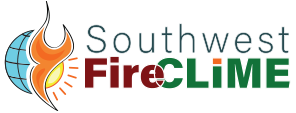
Resource Catalog
Document
The purpose of this paper is to quantify climatic controls on the area burned by fire in different vegetation types in the western United States. We demonstrate that wildfire area burned (WFAB) in the American West was controlled by climate during the 20th century (1916-2003). Persistent ecosystem-specific correlations between climate and WFAB are grouped by vegetation type (ecoprovinces). Most mountainous ecoprovinces exhibit strong year-of-fire relationships with low precipitation, low Palmer drought severity index (PDSI), and high temperature. Grass- and shrub-dominated ecoprovinces had positive relationships with antecedent precipitation or PDSI. For 1977-2003, a few climate variables explain 33-87% (mean = 64%) of WFAB, indicating strong linkages between climate and area burned. For 1916-2003, the relationships are weaker, but climate explained 25-57% (mean = 39%) of the variability. The variance in WFAB is proportional to the mean squared for different data sets at different spatial scales. The importance of antecedent climate (summer drought in forested ecosystems and antecedent winter precipitation in shrub and grassland ecosystems) indicates that the mechanism behind the observed fire-climate relationships is climatic preconditioning of large areas of low fuel moisture via drying of existing fuels or fuel production and drying. The impacts of climate change on fire regimes will therefore vary with the relative energy or water limitations of ecosystems. Ecoprovinces proved a useful compromise between ecologically imprecise state-level and localized gridded fire data. The differences in climate-fire relationships among the ecoprovinces underscore the need to consider ecological context (vegetation, fuels, and seasonal climate) to identify specific climate drivers of WFAB. Despite the possible influence of fire suppression, exclusion, and fuel treatment, WFAB is still substantially controlled by climate. The implications for planning and management are that future WFAB and adaptation to climate change will likely depend on ecosystem-specific, seasonal variation in climate. In fuel-limited ecosystems, fuel treatments can probably mitigate fire vulnerability and increase resilience more readily than in climate-limited ecosystems, in which large severe fires under extreme weather conditions will continue to account for most area burned.
Cataloging Information
- adaptation
- area burned
- Cascade Range
- chaparral
- climate change
- climatology
- deserts
- drought
- ecoprovinces
- ecosystem dynamics
- ecosystem management
- energy
- FERA - Fire and Environmental Research Applications Team
- fire management
- fire regimes
- fire size
- fire suppression
- forest management
- fuel management
- fuel moisture
- grasses
- moisture
- mountains
- precipitation
- range management
- resilience
- season of fire
- shrubs
- statistical analysis
- suppression
- temperature
- vegetation surveys
- vegetation types
- water
- wildfires

This bibliographic record was either created or modified by Tall Timbers and is provided without charge to promote research and education in Fire Ecology. The E.V. Komarek Fire Ecology Database is the intellectual property of Tall Timbers.
